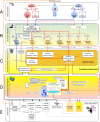Practical aspects of NGS-based pathways analysis for personalized cancer science and medicine
- PMID: 27191992
- PMCID: PMC5239569
- DOI: 10.18632/oncotarget.9370
Practical aspects of NGS-based pathways analysis for personalized cancer science and medicine
Abstract
Nowadays, the personalized approach to health care and cancer care in particular is becoming more and more popular and is taking an important place in the translational medicine paradigm. In some cases, detection of the patient-specific individual mutations that point to a targeted therapy has already become a routine practice for clinical oncologists. Wider panels of genetic markers are also on the market which cover a greater number of possible oncogenes including those with lower reliability of resulting medical conclusions. In light of the large availability of high-throughput technologies, it is very tempting to use complete patient-specific New Generation Sequencing (NGS) or other "omics" data for cancer treatment guidance. However, there are still no gold standard methods and protocols to evaluate them. Here we will discuss the clinical utility of each of the data types and describe a systems biology approach adapted for single patient measurements. We will try to summarize the current state of the field focusing on the clinically relevant case-studies and practical aspects of data processing.
Keywords: next generation sequencing (NGS); pathways; personalized medicine; precision oncology; systems biology.
Conflict of interest statement
The authors declare that there are no conflicts of interest.
Figures

Similar articles
-
Next Generation Sequencing (NGS): A Revolutionary Technology in Pharmacogenomics and Personalized Medicine in Cancer.Adv Exp Med Biol. 2019;1168:9-30. doi: 10.1007/978-3-030-24100-1_2. Adv Exp Med Biol. 2019. PMID: 31713162 Review.
-
Molecular Tumor Boards in Clinical Practice.Trends Cancer. 2020 Sep;6(9):738-744. doi: 10.1016/j.trecan.2020.05.008. Epub 2020 Jun 6. Trends Cancer. 2020. PMID: 32517959
-
A Window Into Clinical Next-Generation Sequencing-Based Oncology Testing Practices.Arch Pathol Lab Med. 2017 Dec;141(12):1679-1685. doi: 10.5858/arpa.2016-0542-CP. Epub 2017 Oct 13. Arch Pathol Lab Med. 2017. PMID: 29028368
-
Next-generation sequencing: hype and hope for development of personalized radiation therapy?Radiat Oncol. 2015 Aug 28;10:183. doi: 10.1186/s13014-015-0481-x. Radiat Oncol. 2015. PMID: 26316159 Free PMC article. Review.
-
Next generation sequencing in cancer: opportunities and challenges for precision cancer medicine.Scand J Clin Lab Invest Suppl. 2016;245:S84-91. doi: 10.1080/00365513.2016.1210331. Epub 2016 Aug 17. Scand J Clin Lab Invest Suppl. 2016. PMID: 27542004
Cited by
-
Enhancing Lung Cancer Classification through Integration of Liquid Biopsy Multi-Omics Data with Machine Learning Techniques.Cancers (Basel). 2023 Sep 14;15(18):4556. doi: 10.3390/cancers15184556. Cancers (Basel). 2023. PMID: 37760525 Free PMC article.
-
Clinical utility of targeted next-generation sequencing assay in IDH-wildtype glioblastoma for therapy decision-making.Neuro Oncol. 2022 Jul 1;24(7):1140-1149. doi: 10.1093/neuonc/noab282. Neuro Oncol. 2022. PMID: 34878541 Free PMC article.
-
Germline and Somatic Tumor Testing in Gynecologic Cancer Care.Obstet Gynecol Clin North Am. 2019 Mar;46(1):37-53. doi: 10.1016/j.ogc.2018.09.003. Obstet Gynecol Clin North Am. 2019. PMID: 30683265 Free PMC article. Review.
-
Biomarkers in colorectal cancer screening.Oncotarget. 2017 Dec 6;8(67):110741-110742. doi: 10.18632/oncotarget.22991. eCollection 2017 Dec 19. Oncotarget. 2017. PMID: 29340012 Free PMC article. No abstract available.
-
Molecular mechanisms underlying resistance to androgen deprivation therapy in prostate cancer.Oncotarget. 2016 Sep 27;7(39):64447-64470. doi: 10.18632/oncotarget.10901. Oncotarget. 2016. PMID: 27487144 Free PMC article. Review.
References
-
- Hanahan D, Weinberg RA. The hallmarks of cancer. Cell. 2000;100:57–70. - PubMed
-
- Center For Drug Evaluation. Genomics - Table of Pharmacogenomic Biomarkers in Drug Labeling. [cited 2015 Oct 2]; Available from: http://www.fda.gov/drugs/scienceresearch/researchareas/pharmacogenetics/....
-
- McCann GA, Eisenhauer EL. Hereditary cancer syndromes with high risk of endometrial and ovarian cancer: surgical options for personalized care. J Surg Oncol. 2015;111:118–24. - PubMed
Publication types
MeSH terms
Substances
LinkOut - more resources
Full Text Sources
Other Literature Sources

